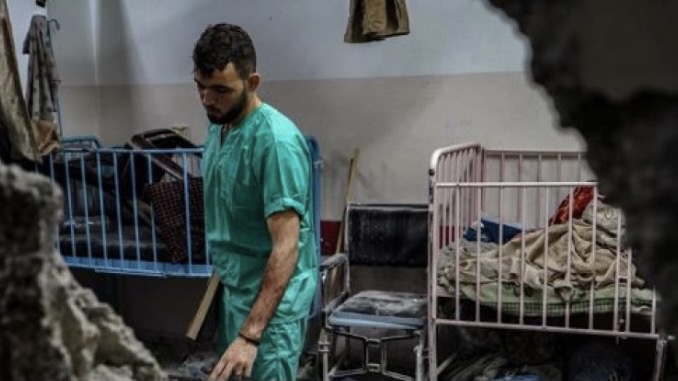In Gaza, Nakba Day witnessed intensified attacks by Israeli soldiers. This included the fatal shooting of a nurse in Jabaliya, northern Gaza, which added yet another name to the list of over 500 health workers who have been killed by the Israeli Occupying Forces (IOF) since October 7, 2023.
Amidst the violence, the remaining hospitals in the Gaza Strip are struggling to maintain operations. On May 14, Doctors Without Borders (MSF) announced the cessation of operations at the Rafah Indonesian Field Hospital, as safety could no longer be guaranteed—making this the 12th health facility in Palestine MSF was forced out of during this war.
The current operational capacity of Gaza’s hospitals is roughly one-third of what it once was, grossly inadequate for addressing the needs of the population. According to United Nations reports, nine field hospitals have been established in the areas of Rafah, Khan Younis, and Deir al-Balah to respond to health demands. However, these facilities cannot compensate for the 24 hospitals that have been put out of order by the attacks.
Especially if the attacks on Rafah continue, field hospitals will not be enough to provide healthcare to everyone in need. “They can in no way replace a functional medical system,” MSF warned.
Read more: Emirati Maternity Hospital in Gaza stops admitting patients, deepening the health crisis
As Israel continues with the incursion into Rafah, access to health care will likely face further setbacks. The UN has reported that approximately 20% of Gaza’s population was displaced, once again, from May 6 to 13 due to the attacks. Many are moving towards Al-Mawasi, a coastal area already overwhelmed by the influx of people, which Israel has designated as a “humanitarian” and “safe” zone.
According to UN estimates, what Israel describes as a “humanitarian area” is within reach of only 5% of Gaza’s core hospital infrastructure: Nasser and Al-Aqsa hospitals. Humanitarian and health organizations have also expressed concern about anywhere in Gaza being referred to as safe, since the decimated infrastructure testifies to Israel’s intention to continue with the destruction of the Strip.
In addition, the hospitals within reach of Al-Mawasi have not been spared until now; direct attacks have devastated Nasser Hospital, which saw extensive damage to hospital buildings and equipment. Reports from the ground also revealed that the IOF left behind not only destruction but also mass graves discovered by Palestinian civil defense teams.
Read more: Mass graves discovered at Nasser Hospital as Israel prepares for Rafah ground invasion
Efforts to restore medical services at Nasser Hospital, including orthopedics, burn units, and soon maternity care, are ongoing. However, these are precarious and could easily be lost again if—or when—Israel changes its designation of Al-Mawasi as a safe zone.
As new field hospitals are being constructed and others rebuilt from the ruins of Israeli attacks, health workers anticipate a worsening public health crisis. The population increase in Rafah has overwhelmed the already strained water and sanitation systems, heightening the risk of infectious diseases. As of May 8, public health officials saw a worrying number of cases of malnutrition and acute diarrhea among young children, as well as widespread acute jaundice syndrome and respiratory infections in the general population.
Despite public health advice from medical staff, the dire living conditions make it nearly impossible for residents to access clean water and nutritious food. In a conversation with Health Workers for Palestine, emergency doctor James Smith emphasized the desperate conditions, noting that many Gazans cannot even afford or trust the safety of the bottled water sold in the area. The living conditions, deliberately shaped by Israel, are designed to inflict suffering, he said.
As the conflict surpasses seven months, the toll is devastating: the IOF has killed more than 35,200 people, injured over 78,000, and presumably left tens of thousands dead under rubble. Women and children are disproportionately affected, as reaffirmed by the World Health Organization. Despite urgent calls for a ceasefire, Israel’s relentless operations suggest a continuing disregard for the catastrophic impact of its war and a determination to pursue its genocidal attacks further.
People’s Health Dispatch is a fortnightly bulletin published by the People’s Health Movement and Peoples Dispatch. For more articles and to subscribe to People’s Health Dispatch, click here.





